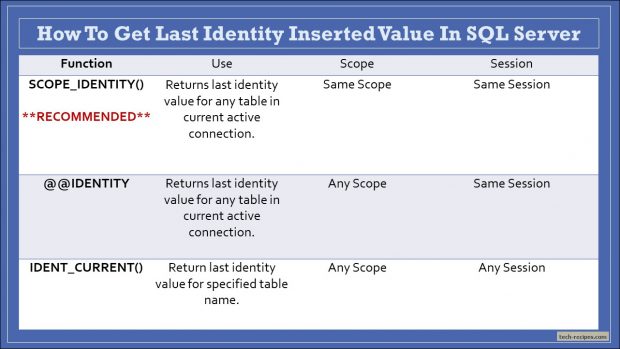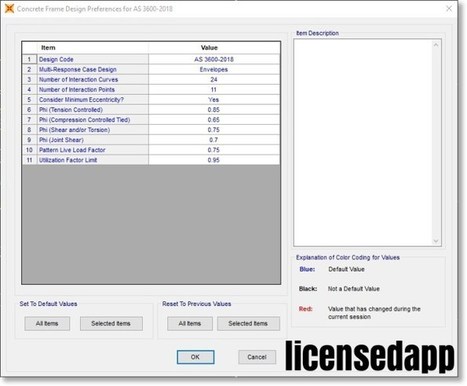What Oracle Object Is Used To Manage Auto-generated Primary Key
Sorry about that - I should have used 9i as well. 10g is doing a better job of smearing the predicate over into V2. 10g is being pretty smart - recognizing that it can spread the predicate against id2 and id3 from V1 into V2 - even though the view V does not have those columns at all. Jul 10, 2012 It is possible to automatically generate a primary key for Oracle Database tables when they are created. The steps below will show how to configure database tables so that primary keys are automatically generated: The following example would create an automatic primary key generation with the following table. In other databases, this is simple, but in Oracle, it was a little complicated - until Oracle 12c. Let's say you wanted to have a unique value generated for a column, such as a primary key value. You wanted this value to be automatically generated when you insert a new record, without having to specify it. Configure Primary Key Generation. Version: 5/12/06. TopLink JPA: How to Configure Primary Key Generation. When using a database that supports sequence objects (such as Oracle Database), you can configure JPA to use a database sequence object to automatically generate identifiers for your persistent objects. And entity lifecycle.
- What Oracle Object Is Used To Manage Auto-generated Primary Key Access
- What Oracle Object Is Used To Manage Auto-generated Primary Key 2017
- What Oracle Object Is Used To Manage Auto-generated Primary Keyboard
- What Oracle Object Is Used To Manage Auto-generated Primary Key Of Life
The Identity column is new to Oracle 12c, and this article explains what it is for and how to use it.
Have you ever needed to generate a unique value for a column, and have it automatically set when you insert a new value?
In other databases, this is simple, but in Oracle, it was a little complicated - until Oracle 12c.
The Problem
Let's say you wanted to have a unique value generated for a column, such as a primary key value. You wanted this value to be automatically generated when you insert a new record, without having to specify it.
If you've used other databases, such as MySQL, this was easy to do. You would just define a column as AUTO_INCREMENT, and whenever you insert a new record, you would leave this column out of the INSERT statement, and the new value would be automatically set.
However, the only way to do this in Oracle is to use a combination of a sequence and a trigger on the table. (LINK)
Until Oracle 12c.
What is an Identity Column in Oracle?
Oracle 12c has introduced the concept of an IDENTITY column. You can set a column as an identity, which works in a similar way to the auto increment column.
Then, whenever you insert a new record into the table, you don't need to specify a value for this column, as it will be generated automatically.
It's a great way to ensure a value is always unique in a column, and to make sure that whoever inserts a record doesn't need to manually call a sequence.
3 Steps total
Step 1: Create table with an Identity column
To set up an identity column, you need to do it as part of the CREATE TABLE or ALTER TABLE statements.
For example:
CREATE TABLE idtest (
new_id NUMBER GENERATED AS IDENTITY,
first_name VARCHAR2(100)
last_name VARCHAR2(100)
);

This means that the new_id column is now an identity column.
If you want to set an existing column as an identity column, I would advise against it. It could cause issues with your data. The better way to do this would be to create a new table and use some renaming of tables to get this done.
Just like with a sequence, you can specify different values and parameters for an identity column.
Let's say you wanted to start your values at 1000, and increment by 5 every time. You can do this in your CREATE TABLE statement:
CREATE TABLE idtest2 (
new_id NUMBER GENERATED AS IDENTITY (START WITH 1000 INCREMENT BY 5)
testval VARCHAR2(50)
);
Whenever you insert new values, they will start at 1000 and go up by 5 (1000, 1005, 1010, 1015).
Step 2: Insert new records into the table
So, now you have set up the identity column, it's time to use it.
To use an identity column, you just run an INSERT statement that does not use this column.
INSERT INTO idtest (first_name, last_name) VALUES (‘Peter’, ‘Parker’);
INSERT INTO idtest (first_name, last_name) VALUES (‘Clark’, ‘Kent’);
INSERT INTO idtest (first_name, last_name) VALUES (‘Bruce’, ‘Wayne’);
Each of these statements will insert a new value in the idtest table. Notice how I did not specify a value for the new_id column.
Step 3: Query table to see that values have been set
Now, to check that the values have been inserted, we can query the table.
SELECT new_id, first_name, last_name
FROM idtest;
You can see that the records exist and that the new_id has been set.
References
- The Full List - Oracle 12c New Features for Developers
0 Comments
What Oracle Object Is Used To Manage Auto-generated Primary Key Access
Similar to MySQL, PostgreSQL, Oracle, and many other relational databases, SQL Server is best utilized when assigning unique primary keys to most database tables.
The advantages to using numeric, auto incremented primary keys are numerous, but the most impactful benefits are faster speed when performing queries and data-independence when searching through thousands of records which might contain frequently altered data elsewhere in the table. With a consistent and unique numeric identifier, applications can take advantage of these faster and more reliable queries.
Basic Table Creation
What Oracle Object Is Used To Manage Auto-generated Primary Key 2017
Once connected to your SQL Server, you’d normally start by CREATING a new table that contains the the field you wish to use as your incremented primary key. For our example, we’ll stick with the tried and true id field:
The problem here is, we have no way of controlling our id field. When a new record is inserted, we not only must manually enter a value for id, but we have to perform a query ahead of time to attempt to verify that id value doesn’t already exist (a near-impossibility when dealing with many simultaneous connections).
What Oracle Object Is Used To Manage Auto-generated Primary Keyboard
Using Identity and Primary Key Constraints
The solution turns out to be using two constraint options provided by SQL Server.
The first is PRIMARY KEY, which as the name suggests, forces the specified column to behave as a completely unique index for the table, allowing for rapid searching and queries.
While SQL Server only allows one PRIMARY KEY constraint assigned to a single table, that PRIMARY KEY can be defined for more than one column. In a multi-column scenario, individual columns can contain duplicate, non-unique values, but the PRIMARY KEY constraint ensures that every combination of constrained values will in fact be unique relative to every other combination.
The second piece of the puzzle is the IDENTITY constraint, which informs SQL Server to auto increment the numeric value within the specified column anytime a new record is INSERTED. While IDENTITYcan accept two arguments of the numeric seed where the values will begin from as well as the increment, these values are typically not specified with the IDENTITY constraint and instead are left as defaults (both default to 1).
What Oracle Object Is Used To Manage Auto-generated Primary Key Of Life
With this new knowledge at our fingertips, we can rewrite our previous CREATE TABLE statement by adding our two new constraints.
Enable Key Generation in Chrome. English on June 6th, 2016 No Comments. The following article refers to the process of generating client certificates at the SSOCircle Public IDP. In the PKI functionality of SSOCircle IDP we allow the automatic generation of keys and the enrollment of X.509 certificates. Client certificates are used for strong. Nov 25, 2016 Linnet's How To Remember to like and subscribe See all my videoes in playlist / categories here https://www.youtube.com/channel/UCmd6xmZpPhJ6I9oe6hn65Hg/pl. Mozilla Firefox: This browser supports key generation and certificate installation by default through the function and special certificate file type handling. Note: While Firefox supports in-browser certificate installation, it uses its own keystore to store the certificate and is not shared with other applications. Installing through. Chrome to permit key generation download.
That’s all there is to it. Now the id column of our books table will be automatically incremented upon every INSERT and the id field is guaranteed to be a unique value as well.
